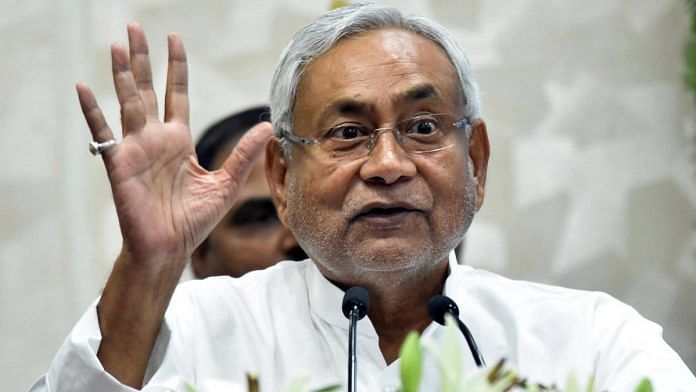Patna: The floods that are wreaking havoc in Bihar could not have come at a worse time for Chief Minister Nitish Kumar and his administration. Already battling a Covid-19 surge in the state, the Nitish administration now has to contend with providing help and rehabilitation to over 38 lakh people who have been affected by the deluge in 12 districts.
The double whammy could prove a major setback for Nitish with assembly elections just months away.
In a review meeting Thursday, the chief minister, sources said, admitted that due to the pandemic, it won’t be possible to construct huge relief camps like the government did during the 2008 Kosi deluge.
“Ensure that the Covid factor is taken into account while providing relief to the victims,” he told officials. “Flood victims entering relief camps should be tested and given masks. Those who test positive should be segregated.”
The chief minister is already under massive pressure over his administration’s handling of the Covid-19 crisis. Of late, Bihar has witnessed a massive spurt in Covid-19 cases — over 3,000 fresh cases were reported Friday, taking the total to 50,987 cases. There have also been over 250 deaths so far.
As of 31 July, Bihar also recorded the lowest number of tests per million at 4,210. The national test per million conducted in India as of the same date was 13,733.
Such has been criticism that Nitish Tuesday shunted out his principal secretary (health department) Uday Singh Kumawat, and replaced him with the 1991-batch IAS officer Pratyaya Amrit, an officer with a stellar reputation in Bihar’s civil services.
The state government has also extended the lockdown until 16 August.
Also read: Bihar govt ‘willing’ to recommend CBI probe into actor Sushant Singh Rajput’s death
The Kosi deluge & the floods of today
The 2008 Kosi deluge is a benchmark for Nitish Kumar as he was at the helm when the then JD(U)-BJP government earned massive praise for its handling of those floods. The government had then set up several mega camps, each with a capacity to hold 10,000 flood victims, complete with food, security and healthcare facilities.
It also reaped Nitish political dividends in the 2010 assembly elections as the JD(U)-BJP combine swept the then flood-hit areas of Madhepura, Saharsa and Purnea — generally considered RJD strongholds.
“The 2008 Kosi floods were different because they were the result of the Kosi river changing course due to a breach in the barrage at Kushha. The flooding was sudden and intense,” said principal secretary (health) Pratyaya Amrit, who also handles the disaster management department.
“This year most of the flood victims have not come out on the roads. We do not need mega camps. But we have taken precautions and have directed the rescue teams to conduct rapid antigen tests on flood victims, sanitise the community kitchens and have also tested the NDRF and SDRF rescue teams for Covid.”
He added that the government has been prepared for the situation since May.
“We knew that floods would come. But the only difference this year is that floods, which usually come in the month of August, have done so in July due to the rains,” Amrit said. “But we are ready to face the worst right until September.”
Experts, however, don’t buy the government’s claim that it is prepared to handle the floods.
“The state government has a short memory. In 1966, the floods came in the month of May as there were rains before it,” said flood expert Dinesh Mishra. “There was always the possibility that flooding would occur earlier this year, as the state has witnessed heavy rains in both June and July. The government should have realised that it would have to face floods and the Covid situation simultaneously.”
Also read: There’s a new Tejashwi Yadav in Bihar & he’s doing everything he didn’t do in past 5 years
The floods and Covid
The floods in Bihar have so far killed 11 people and have resulted in those affected taking refuge on national and state highways. In several cases, primary health centres of the flood-hit areas have had to be abandoned.
“When embankments were built to prevent the flooding, there was a plan to shift out the population that was living within the embankments. It was never done,” said Dinesh Mishra. “They continue to live within the embankments and are uprooted by the yearly floods. Today an estimated 40 lakh people live within the embankments. There is very little medical infrastructure even in normal times. One can just imagine their plight in this Covid situation.”
The forecast also makes for grim reading. The bulletin issued by the water resources department Thursday said that the rivers Bagmati, Gadak, Kamala Balan, and even Ganga are flowing above the danger level at several places. The weather forecasts also indicate more rain, especially in the catchment areas of these rivers falling in Nepal.
Also read: Bihar bridge collapses month after inauguration, opposition says Nitish corruption exposed






